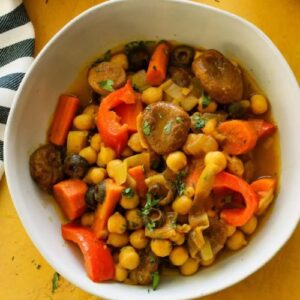
Curried Chickpea Apricot Stew
A vibrant, plant-based stew blending chickpeas, sweet apricots, and aromatic spices. Packed with protein, fiber, and flavor, this cozy dish is quick to prepare and perfect for weeknight meals or meal prep. Serve over quinoa or your favorite grain for a hearty, healthy dinner.
Equipment
- 1 large saucepan or pot
- 1 cutting board
- 1 chef’s knife
- Measuring Cups and Spoons
- Wooden spoon or spatula
- Serving bowls
Ingredients
- ¼ cup vegetable broth or avocado oil for oil-based version
- 1 leek cleaned and sliced into 1/4” rounds
- 1 bell pepper diced
- 1 small sweet white onion chopped
- 3 –4 medium carrots peeled and sliced
- 1 15 oz can chickpeas (garbanzo beans), drained and rinsed
- ¼ tsp garlic powder
- 2 tsp curry powder
- 2 tsp ground cumin
- 1 ½ tsp sweet paprika
- ½ tsp ground turmeric
- ⅛ tsp ground ginger
- Pinch of ground cinnamon
- ½ cup dried apricots chopped or whole
- ¼ cup black olives sliced
- 2 ½ cups low-sodium vegetable broth
- Handful fresh cilantro roughly chopped (for garnish)
- Cooked quinoa or preferred grain for serving
Instructions
- Prepare Your Ingredients: Before you start cooking, make sure all your ingredients are prepped and ready. Rinse the leek thoroughly under cold running water to remove any dirt trapped between the layers, then slice it into 1/4-inch thick rounds. Dice the bell pepper into even pieces so they cook uniformly. Chop the sweet white onion finely, peel and slice the carrots into thin rounds or half-moons, and roughly chop the dried apricots. Rinse the canned chickpeas under cold water and drain well. Having everything ready will make the cooking process smooth and stress-free.
- Heat the Base for Flavor: Place a large saucepan or heavy-bottomed pot over medium-high heat. Pour in 1/4 cup of vegetable broth, which will act as your sauté base. (If you prefer an oil-based version, substitute avocado oil here for richer flavor.) Allow the broth to warm until it’s gently shimmering but not boiling. This initial step helps develop depth in the stew without excessive oil.
- Sauté Aromatics: Add the sliced leek, diced bell pepper, and chopped onion to the heated pan. Stir gently to coat the vegetables in the warm liquid. Sauté for about 5 minutes, stirring occasionally, until the onion becomes translucent and fragrant. You’ll notice the aroma intensifying, and the vegetables will begin to soften — this builds the foundational flavor for your stew.
- Incorporate Chickpeas and Spices: Once the aromatics are softened, add the drained chickpeas and sliced carrots to the pan. Sprinkle in the garlic powder, curry powder, ground cumin, sweet paprika, ground turmeric, ground ginger, and a pinch of cinnamon. Stir continuously for about one minute, allowing the spices to bloom and release their fragrances. This step is crucial for building a rich, layered taste profile that will define the stew.
- Add the Liquid and Sweet Elements: Pour in the low-sodium vegetable broth slowly, stirring as you pour to ensure the spices integrate evenly. Add the chopped dried apricots and sliced black olives at this stage. The apricots will infuse the stew with natural sweetness while the olives add a subtle briny depth. Stir gently to combine all ingredients.
- Simmer and Develop Flavor: Bring the stew to a gentle boil over medium-high heat. Once boiling, reduce the heat to medium-low and cover the pot with a tight-fitting lid. Let the stew simmer for 20 minutes, stirring occasionally. During this time, the flavors will meld together, the carrots will become tender, and the apricots will soften into the broth, enriching the stew with sweetness and body.
- Cook the Grain for Serving: While the stew simmers, prepare your chosen grain according to package instructions. Quinoa works beautifully with this stew and absorbs its flavors well, but rice or couscous are also excellent choices. Cooking your grain in parallel saves time and ensures the meal is ready all at once.
- Taste and Adjust Seasoning: After simmering, uncover the pot and give the stew a final stir. Taste and adjust seasonings as needed — add more curry powder for warmth, a pinch of salt for balance, or a squeeze of lemon juice for brightness. This final adjustment ensures your stew hits the perfect harmony of sweet, savory, and spiced flavors.
- Serve with Grain and Garnish: Spoon a generous portion of the stew over a bed of cooked quinoa or your preferred grain. Garnish with a handful of roughly chopped fresh cilantro for freshness and visual appeal. The cilantro adds a vibrant note that complements the stew’s rich flavors beautifully.
- Store and Reheat: Leftovers can be stored in an airtight container in the refrigerator for up to 3–5 days. To reheat, warm gently on the stovetop over low heat, adding a splash of vegetable broth if needed to loosen the stew. This dish also freezes well — store in a freezer-safe container for up to 3 months and thaw overnight before reheating.
Notes
- Use low-sodium vegetable broth to better control salt levels and highlight the spices’ natural flavors.
- For a richer version, substitute vegetable broth with light coconut milk for creaminess.
- Chopping vegetables uniformly helps ensure even cooking and consistent texture.
- Dried apricots can be swapped with golden raisins or dried figs for a different sweetness profile.
- This stew tastes even better the next day as flavors deepen, making it ideal for meal prep.